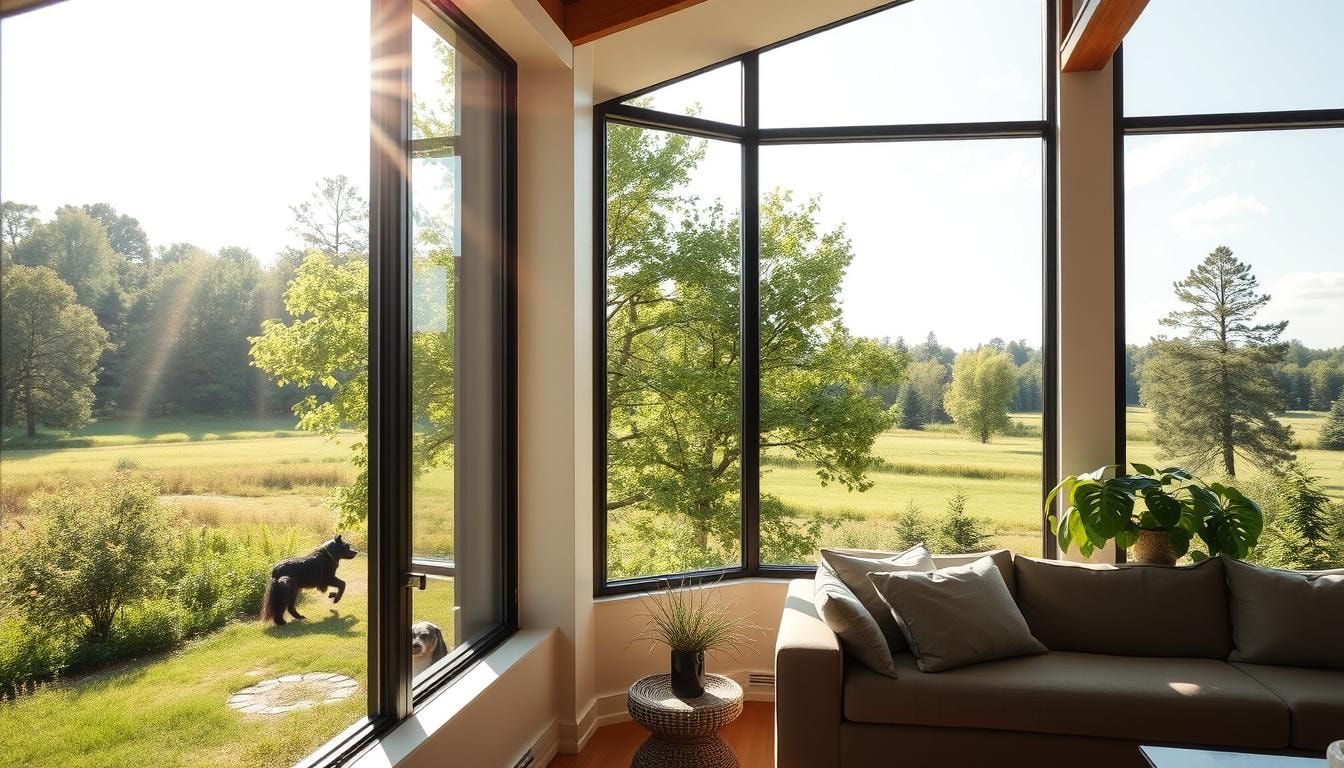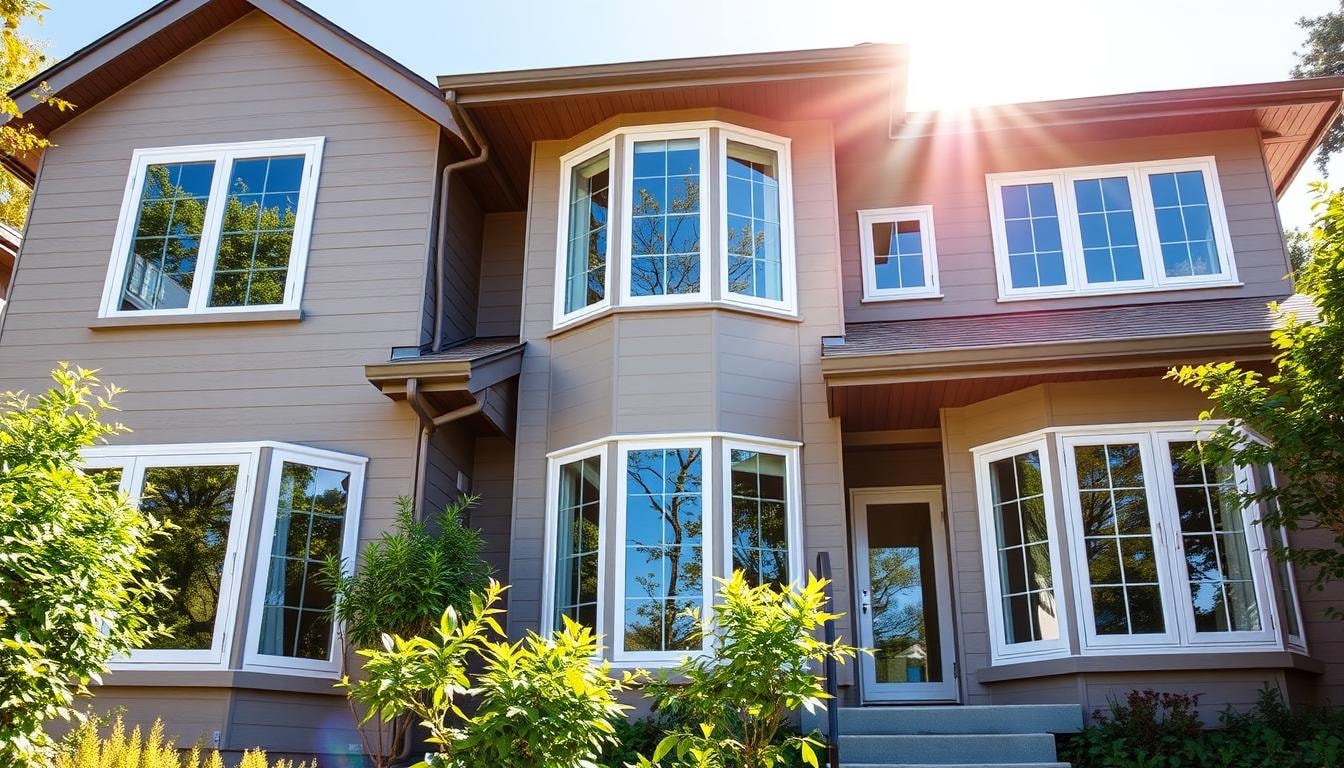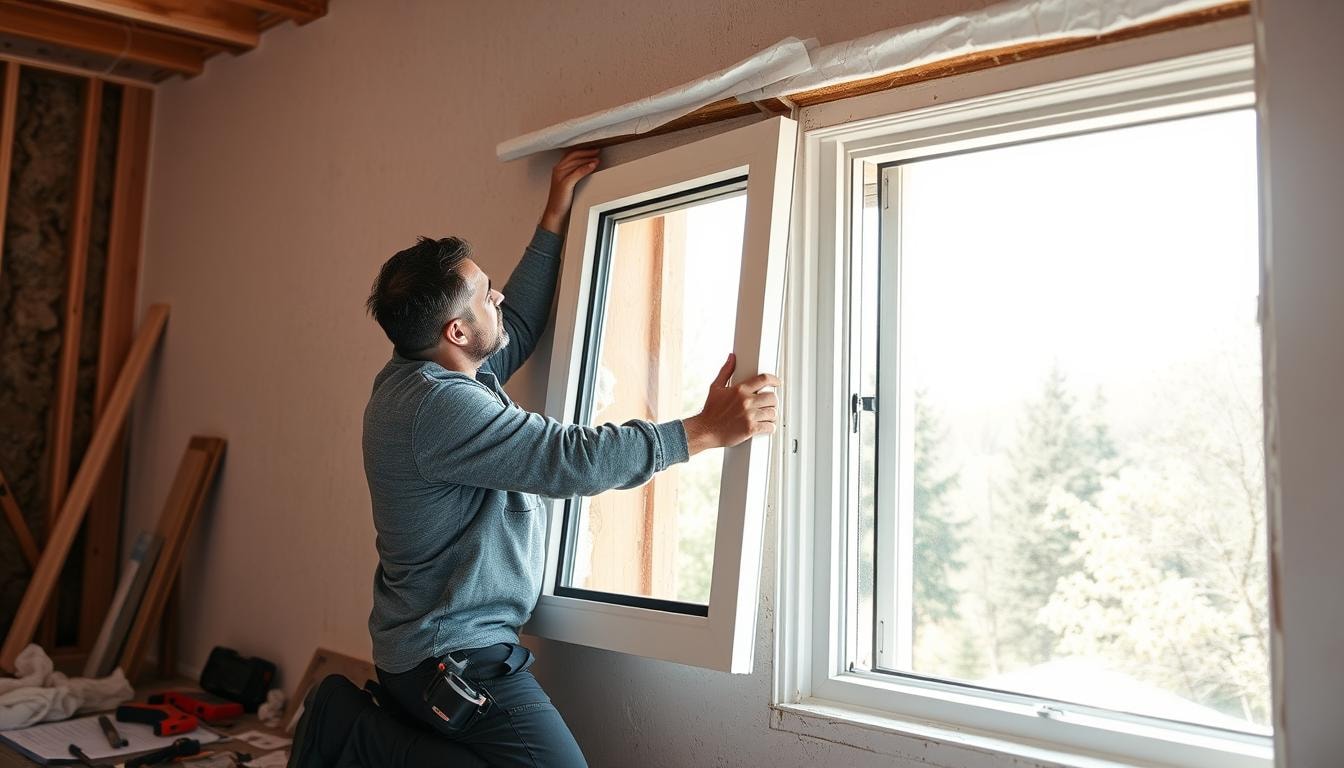
Does Replacing Windows Damage Walls? A Quick Guide
Replacing windows is a big home improvement project. Many people worry about damaging their walls. But, with the right prep and a pro’s help, risks can be low.
Homeowners often fear the mess and disruption of replacing windows. They need to find a good window company, schedule visits, and confirm dates. Then, the actual replacement happens. This can lead to dust, debris, paint chips, and more.
But, a pro window installer can help a lot. They know how to avoid damage and clean up well. This makes the whole process easier for homeowners.
Key Takeaways
- Window replacement can potentially cause wall damage, but proper preparation and professional installation can minimize risks.
- The process involves finding a reputable window installation company, scheduling site visits, confirming installation dates, and the actual window replacement.
- Potential wall damage includes dust, debris, paint chips, wood shavings, dirt, and plaster issues.
- Professional window installers are trained to minimize damage and thoroughly clean up after the job, ensuring a smooth process.
- Homeowners should consider the benefits of working with a professional window installation company to protect their home’s walls and ensure a successful project.
Understanding Window Replacement and Wall Impact
Window replacement can affect the walls around it. The team removing old windows might damage the walls. Knowing the process helps homeowners manage the project better.
The Basic Process of Window Replacement
The steps for replacing windows are:
- Removing the old windows, which might need some demolition.
- Cleaning and preparing the window opening for the new ones.
- Installing the new windows, which can change the wall’s look and feel.
- Adding the final touches, like trimming and sealing the new windows.
Common Areas of Wall Concern
Walls can be a worry during window replacement. The main concerns are:
- Interior walls, where paint or plaster might get damaged.
- Exterior walls, where the window frame and finishes can be affected.
- Trim and molding, which might need to be removed and put back.
- The wall framing, which supports the window and can have minor issues.
Types of Potential Damage
There are several ways walls can get damaged during replacement:
- Paint chipping or peeling off the walls
- Plaster or drywall cracking or crumbling
- Damage to trim and molding around the window
- Minor structural issues, like cracks or gaps, in the wall framing
Understanding the process and common concerns helps homeowners. They can work with their team to make the replacement smooth. This way, the new windows will be energy-efficient and look great.
Common Types of Wall Damage During Window Installation
Replacing windows is a big job. It’s important to know how it can affect your home’s walls. Different types of damage can happen, from small issues to big problems. Knowing about these can help you get ready and fix any wall problems.
One common problem is plaster or drywall cracks. Taking out old windows and putting in new ones can stress the walls. This can cause small cracks or bigger damage. Also, water from bad window installation can lead to rot and mold, making the walls weak.
Older homes with weak structures around windows can face bigger damage. Over time, window frames can warp or get weak. This makes the wall unstable, leading to cracks, crumbling, or even wall collapse.
- Plaster or drywall cracks
- Water damage and mold growth
- Structural issues due to aging window frames
- Paint chipping or peeling
- Damage to trim and molding
Using the right techniques and materials is key to avoid wall damage. Talking to experienced pros can help make the process smooth. It also keeps your home’s walls safe.
Interior Wall Considerations and Risks
When you replace windows, think about how it might affect your home’s walls. New windows can cause problems like paint and wallpaper damage. They can also harm plaster, drywall, and even trim and molding.
- Paint and Wallpaper Damage: Replacing windows can be tricky. Even small scratches or scuffs can ruin the paint or wallpaper. It’s important to handle things carefully and protect the area around the window.
- Plaster and Drywall Issues: In older homes, taking out old windows can lead to cracks or crumbling in plaster or drywall. This is more common in areas where the walls have weakened over time. You might need to prepare and reinforce the walls to avoid problems.
- Trim and Molding Concerns: Removing old windows can damage the trim and molding if not done right. It’s crucial to remove them carefully and put them back exactly as they were. This helps keep your walls looking good.
When installing new windows, pay close attention to detail. This helps protect your home’s interior. Knowing the risks and taking the right steps can make the process go smoothly and keep your walls intact.
Exterior Wall Impact Assessment
Window replacement can really affect your house’s exterior walls. Removing old windows and putting in new ones can harm the brick, siding, or stucco. If the new windows don’t fit right, you might see gaps and water damage.
It’s important to have experts check your walls before and after new windows are installed. They can spot problems like cracks or chips. Then, they can fix these issues to keep your home looking good and safe.
Getting your walls checked before the replacement can save you money later. Fixing problems early means your new windows will make your home look better and work better. This way, you avoid wall damage or removal problems.
Choosing the right professionals is key to protecting your house. They can help reduce how much damage happens during the installed window replacement. Work with experienced contractors who care about keeping your exterior walls safe and looking great.
Professional Installation vs. DIY: Impact on Wall Integrity
Choosing between professional installation and DIY for window replacement affects your home’s walls. DIY might seem cheaper at first, but it can cause more harm than good. This can lead to costly repairs later on.
Benefits of Professional Installation
Experts in window installation know how to avoid damaging your walls. They use the right tools and methods to fit windows perfectly. This prevents damage to paint, drywall, and other parts of your walls.
Common DIY Mistakes to Avoid
- Incorrect measurements leading to ill-fitting windows
- Inadequate waterproofing and sealing, resulting in air and water leaks
- Damage to surrounding materials, such as drywall, trim, and paint
Cost Implications of Damage Prevention
Professional installation might cost more upfront, but it saves money in the long run. It prevents costly repairs and keeps your home energy-efficient. Plus, pros are insured and offer warranties for extra peace of mind.
Going with a professional ensures your walls stay safe and your home’s value stays high.
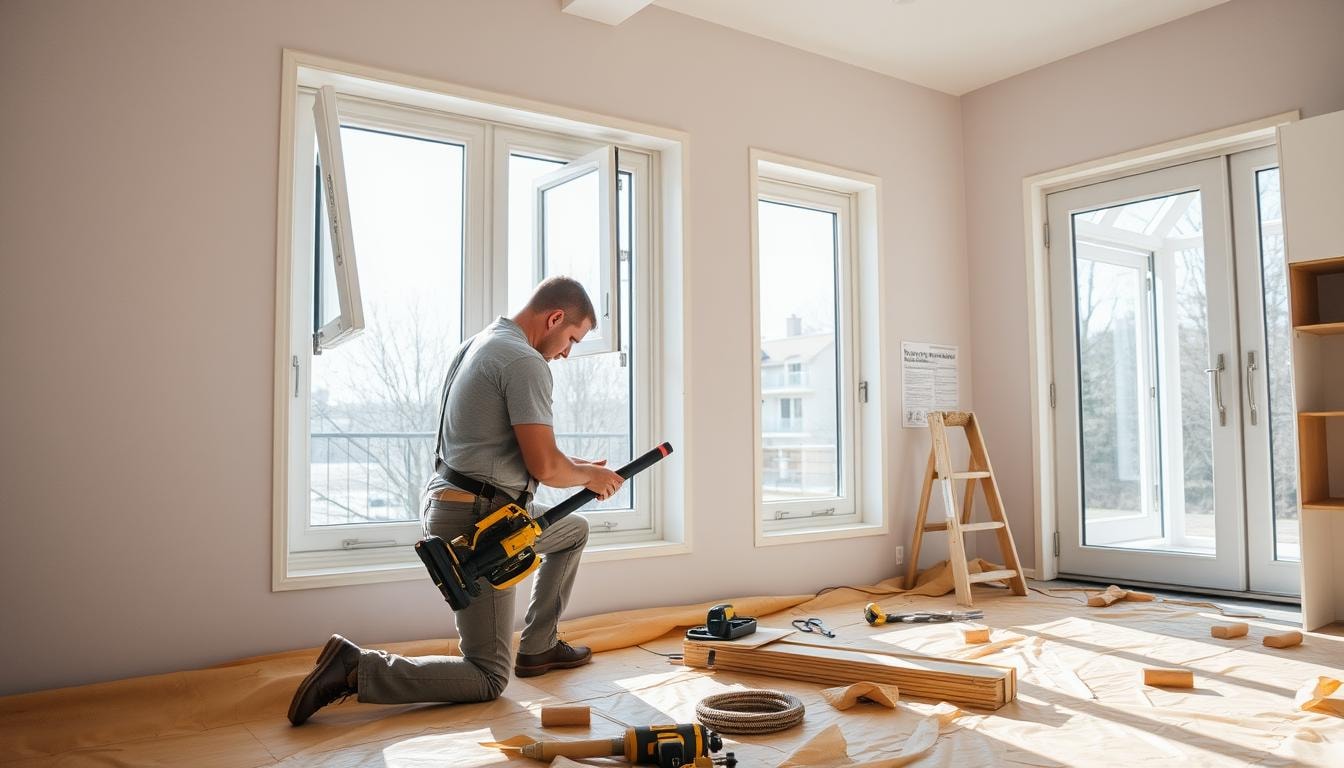
Prevention and Protection Measures
When replacing windows, it’s key to protect your walls. Proper preparation and using protective materials help keep your walls safe. This is true for both inside and outside walls.
Preparation Steps
Before starting, make sure to do these things:
- Move all furniture and decor away from the work area to create a clear path for the installation team.
- Cover the floor and any remaining items with dust sheets or tarps to protect them from debris.
- Ensure the installation team has easy access to the work area by clearing any obstacles or hazards.
Protective Materials and Methods
To protect your walls, use these materials and methods:
- Plastic sheeting or tarps: Hang these around the work area to contain dust and debris.
- Painter’s tape: Apply this to the perimeter of the window opening to prevent paint or wallpaper damage.
- Drop cloths: Lay these on the floor to catch any falling tools or materials.
- Ventilation: Ensure proper airflow to minimize the impact of dust and debris on your home.
- Pre-installation communication: Discuss the protection measures with the installation team to ensure everyone is on the same page.
- Temporary sealing: Consider temporarily sealing the window opening between removal and installation to prevent weather-related damage.
By taking these steps, you can reduce the risk of wall damage. This makes your window replacement project smoother and easier.
Post-Installation Repairs and Solutions
After putting in new windows, check your walls for damage. Even small cracks or paint chips can happen. These are easy to fix with a little effort.
For bigger problems, like drywall or plaster damage, get a pro. They can fix the walls to look like before. Make sure to paint and fix any trim or molding too.
Don’t forget to check the outside walls for damage. Fixing siding or brickwork is important. Also, seal the new windows well to avoid leaks or drafts. Clean up the area well after fixing things.
If you need to fix a lot, think about painting the whole room. This makes everything look new and fresh. It’s all about making your home look great again.
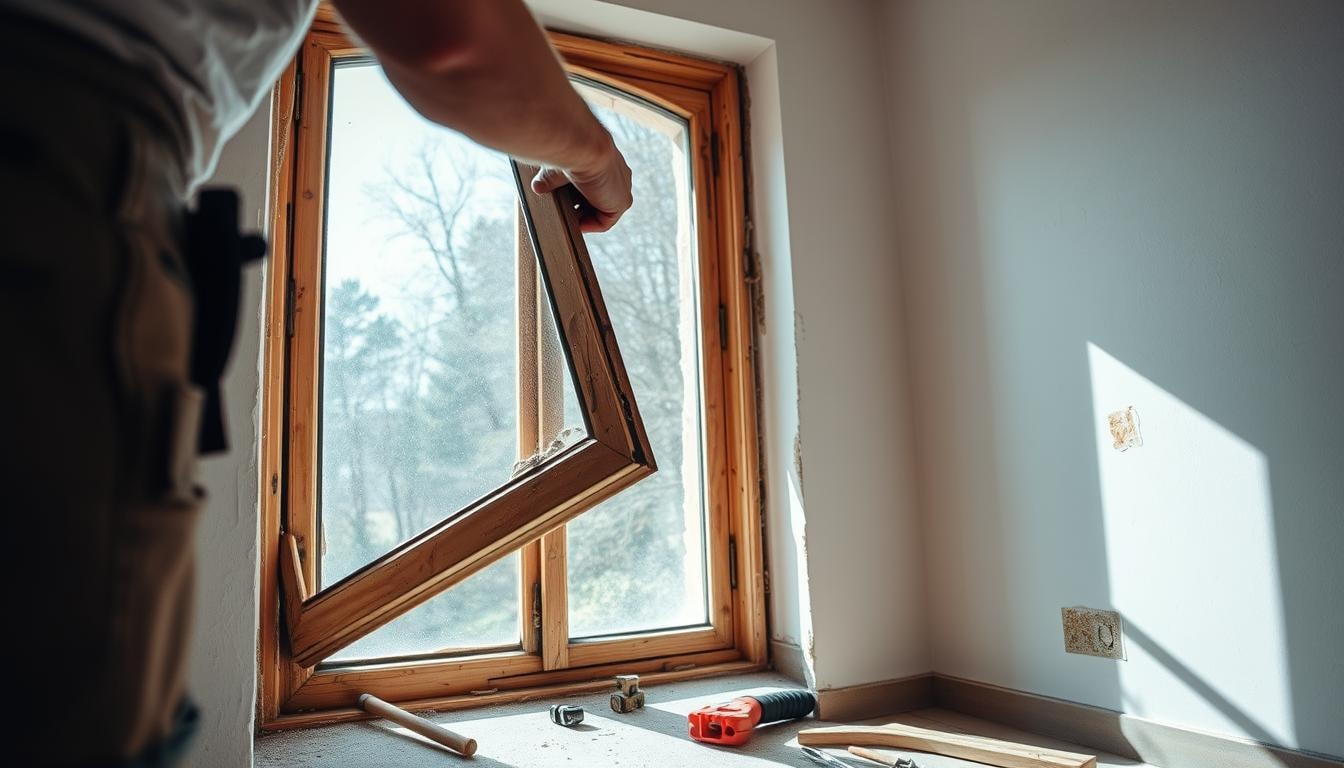
Fixing problems after installing windows is key to keeping your home in good shape. It doesn’t matter if it’s a small fix or a big one. Taking care of it now will save you trouble later.
Get Expert Window Replacement Advice from Budget Windows
Are you considering replacing the windows in your home but concerned about the potential impact on your walls and property? Don’t worry – the experts at Budget Windows are here to help ensure a smooth installation process. Our experienced team knows how to properly fit new windows while minimizing any damage caused to your window jambs, surrounding walls, or ceiling.
We’ll work closely with you to manage the entire installation process, using expanding foam and other techniques to fill gaps and provide a tight, energy-efficient seal around your newly fitted windows. When you choose Budget Windows, you can expect a stress-free experience and beautiful, high-performance windows that will enhance your property for years to come. Contact us today to schedule a consultation and get the expert advice you need for a successful window replacement project.
Conclusion
Window replacement can sometimes harm walls, but careful planning and professional help can reduce this risk. New windows bring many benefits like better energy use, comfort, and home value. These advantages often make up for the short-term trouble and minor damage.
Homeowners with older homes should think carefully about their choices. They should pick trusted professionals and get ready for the job. This way, they can get the best results.
Keeping windows and walls in good shape helps avoid future problems. Fixing old windows, high energy bills, and safety issues can make homes better. This leads to better performance and looks.
With the right steps and focus, replacing windows can be done well and quickly. It makes homes more comfortable, energy-efficient, and valuable in the long run.
FAQs
How can window replacement potentially damage walls?
Window replacement can potentially cause damage like paint chipping, plaster/drywall cracking, and issues with trim and molding around the windows. Older homes with weak structures around windows are more susceptible to bigger damage.
What are the benefits of using a professional for window installation versus doing it myself?
Professional installers know how to properly fit the new windows and use the right techniques to avoid damaging your walls. DIY mistakes like incorrect measurements or poor sealing can lead to air/water leaks and costly wall repairs later on.
What steps can I take to protect my walls during the window replacement process?
Prepare by moving furniture, covering floors, and clearing the work area. Use protective materials like plastic sheeting, painter’s tape, and drop cloths. Ensure proper ventilation and communicate with the installation team about your wall protection needs.
How should I address any wall damage that occurs after the new windows are installed?
Inspect your walls carefully after installation. Minor issues like small cracks or paint chips can often be easily fixed. For bigger problems like drywall or plaster damage, it’s best to hire a professional to properly repair and restore the walls.
How can replacing my existing windows improve my home’s energy efficiency?
New, properly-fitted replacement windows can significantly boost your home’s energy efficiency. They help prevent air leaks and improve insulation, leading to lower energy bills and a more comfortable living environment.





